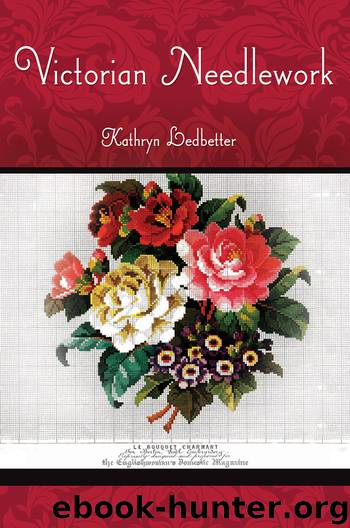Victorian Needlework by Kathryn Ledbetter

Author:Kathryn Ledbetter
Language: eng
Format: epub
Publisher: ABC-CLIO
Published: 2012-03-02T16:00:00+00:00
NEEDLEWORK TOOLS
An inventory of common needlework tools and supplies is a cornucopia of nineteenth-century British machine-made improvements or inventions specifically designed and marketed for the profitable business in needlework. A brief list of items other than the most essential pins and needles would include the following:
Thimbles: provided protection for fingers from needle pricks. These may be decorated profusely or not at all. They were made of many materials, including brass, bronze, bone, ivory, leather, porcelain, mother-of-pearl, aluminum, wood, stone, glass, tortoiseshell, gold, silver, steel, aluminum, or celluloid, which was an artificial polymer plastic often called xylonite. Englishman Alexander Parkes invented this material in 1862, and American John Hyatt improved it for common use in the 1870s. Thérèse de Dillmont recommends nickled thimbles: “Those of bone are very liable to break, and silver ones are not always deeply enough pitted to keep the needle from slipping. A good thimble should be light, with a slightly rounded top and a flat rim.”4 Before the 1880s, English thimbles came in three sizes for girls, young women, and women. Thimbles were often given as precious gifts, with a wide range of pricing.
Crochet hooks: hook-ended tools made of tortoiseshell, bone, or boxwood for coarse work in cotton or flax thread, with smaller steel hooks reserved for fine work. The working end was to be well polished and not too pointed, while the back should be slightly rounded and “light enough not to tire the hand.”5 A good hook is firm, smooth, and of a size adequate for the thread being used.
Scissors: steel cutlery with good points and a sharp edge (Dillmont recommends two pair, large and small). Before the 1830s, all scissors were handmade. England did not make machine-forged scissors until the 1880s. Until then, Sheffield manufacturers dominated the market. Joseph Rodgers & Sons reportedly produced 7,200 pairs of scissors per week during the 1860s. Sheffield steel manufacturers made highly prized, expensive, hand-forged steel scissors worked by skilled artisans. However, iron shears could also be purchased, as well as cheaper steel scissors machine-forged in France, Germany, and the United States.
Knitting needles: gently pointed needles (often called pins in Britain) made from long steel, wood, ivory, or bone; yarn (usually wool, cotton, or silk); and a gauge to measure needle sizes. Early in the Victorian period, a worker might also use a knitting sheath to secure the needles in her lap.
Needle gauges: tools with holes that determine the size of knitting needles. These were made from cardboard, ivory, or wire.
Stilettos: pointed metal tools for pricking fabric, consisting of a sewing needle screwed into a metal handle. “By means of this stiletto, the material is pierced at the point where the thread is to enter and a passage prepared for the needle used for the embroidery.”6
Other basic tools: pincushions and emery (the material inside pincushions that removed rust from pins and needles) and a tape measure. Exact measurements were not standard until 1855, when Parliament authorized the Imperial Standard Yard metal bar. It was 16 parts of copper, 2-½ parts of tin, and 1 part of zinc.
Download
This site does not store any files on its server. We only index and link to content provided by other sites. Please contact the content providers to delete copyright contents if any and email us, we'll remove relevant links or contents immediately.
On Writing A Memoir of the Craft by Stephen King(4848)
The Doodle Revolution by Sunni Brown(4668)
A Simplified Life by Emily Ley(4081)
Mummy Knew by Lisa James(3621)
Marijuana Grower's Handbook by Ed Rosenthal(3606)
Better Homes and Gardens New Cookbook by Better Homes & Gardens(3509)
Figure Drawing for Artists by Steve Huston(3363)
Paper Parties by Erin Hung(3354)
Draw Your Day by Samantha Dion Baker(3258)
The Genius of Japanese Carpentry by Azby Brown(3209)
Japanese Design by Patricia J. Graham(3098)
The Code Book by Simon Singh(3057)
Dangerous Girls by Haas Abigail(2958)
Lions and Lace by Meagan Mckinney(2911)
The Curated Closet by Anuschka Rees(2897)
How to Make Your Own Soap by Sally Hornsey(2812)
The Checklist Manifesto by Atul Gawande(2763)
The Wardrobe Wakeup by Lois Joy Johnson(2717)
Zero to Make by David Lang(2716)
